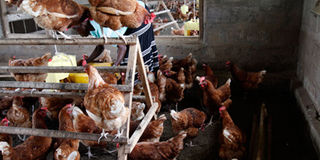Gumboro: What every farmer should know in 2019

Susan Achieng feeds layers at her poultry farm. Most farmers are faced with a disease burden in their brooders. Photo by Rachel Mabala
What you need to know:
SUMMARY: Gumboro is deadly because it leads to low weight in chicken and can wipe out an entire brood, writes Jane Maina.
Infectious bursal disease (IBD), also known as Gumboro, is a contagious viral infection that attacks poultry, but mainly chickens.
The disease particularly affects birds older than three weeks. The feathers around the vent are stained with faecal substance containing plenty of urates (uric salt). Gumboro is deadly because it leads to low weight in chicken and can wipe out an entire brood.
What causes the disease and how it is spread?
The disease is caused by a virus that is shed in the droppings and transferred from house to house by fomites (objects that have been in contact with sick birds such as bedding, drinking and feeding equipment, attendants’ feet, clothes and hands).
The IBD virus is stubborn and can be difficult to eradicate. However, it is important to note that there is no vertical transmission, that is, from parents to offspring.
How to recognise the disease
The severity of the infection depends on the age and breed of chicken and the virulence of the virus. Two forms of the disease may occur:-
Sub-clinical form: This is when the infection may be present without the birds showing any signs.
This is common in birds less than three weeks old. The young birds will not respond well to vaccination and are prone to other infections.
Clinical form: This happens to birds of three to six weeks of age. The signs include severe prostration, watery diarrhoea, soiled vent feathers, vent picking, and inflammation of the cloaca (passage for droppings). Deaths occur from day three and peaks at day five to seven. Recovery starts in less than one week but broiler weight gain is affected and delayed.
Treatment and control
There is no treatment for IBD but a farmer can use support therapies that include offering the birds vitamin supplements.
More importantly, the farmer must vaccinate the birds. The vaccine is administered via eye drops, drinking water or injection at between one to 21 days.
Breeder flocks must also be vaccinated one or more times, first with a live vaccine and again just before egg production.
The immune status of breeder flocks, however, should be monitored periodically so that if antibody levels fall, hens should be re-vaccinated to maintain adequate immunity. Gumboro vaccine is readily available at agrovet dealers outlets countrywide.




